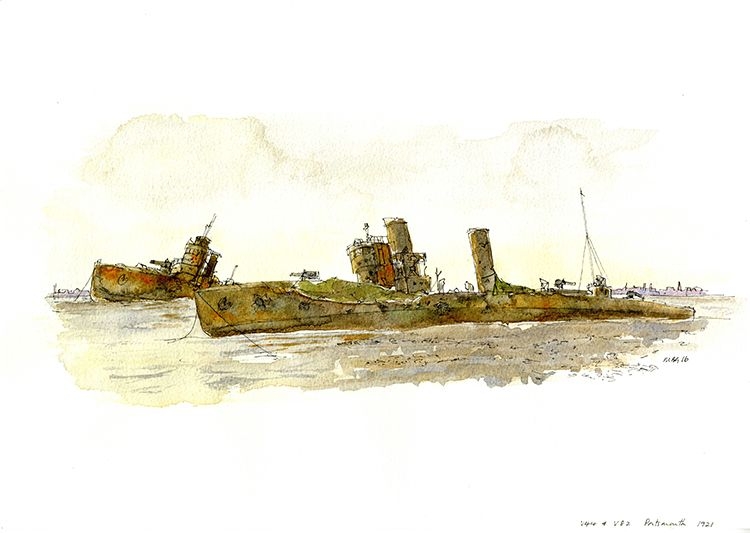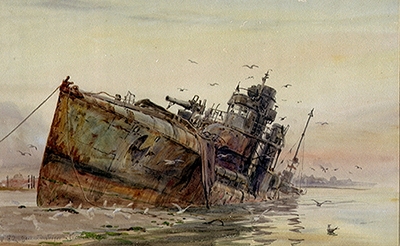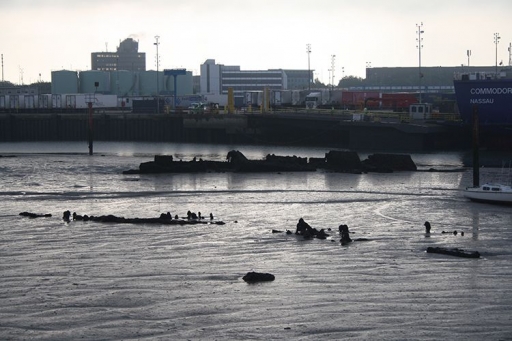The wrecks of two German First World War destroyers have been identified at Britain’s main naval base.
One of the warships rediscovered by archaeologists in Portsmouth Harbour has been identified as a veteran of the Battle of Jutland.
Both surrendered with the German fleet in 1918 and were later used for target practice in Portsmouth before being sold for scrap.
Today, their remains lie buried in mudflats opposite a cross-channel ferry terminal, exposed only at very low tide.
News of the find has heightened significance in 2016 as Portsmouth prepares to host events marking the centenary of Jutland, the biggest naval battle of the Great War.
”Very little of the German High Seas Fleet remains today and still less can be seen above the waterline,” says the Maritime Archaeology Trust (MAT).
Researchers have pieced together the story of the wrecks from British and German sources, with help from academics and volunteers.
Their identification – as the destroyers V44 and V82 – has come about as part of MAT’s Heritage Lottery-funded project exploring Forgotten Wrecks of the First World War on England’s south coast. Artistic impression of V44 and V82, shortly after beaching at Whale Island, Portsmouth (Reproduced with permission of Mike Greaves, ASGFA, Greaves2Connections)
Artistic impression of V44 and V82, shortly after beaching at Whale Island, Portsmouth (Reproduced with permission of Mike Greaves, ASGFA, Greaves2Connections)
Archaeologist Dr Julian Whitewright found the first clues to the ships’ origins in photographs dating from 1939.
Looking at modern imagery, he was amazed to find that the wrecks were still in place: “Many historical features and artefacts have been picked up in old photography, but when you come to look in the present day, most have been removed or destroyed.
“Thousands of old ships have been abandoned in Portsmouth Harbour over the years, sometimes for decades, but it’s very rare for any evidence of them to still be there today.”
Further research in UK Hydrographic Office reports revealed that the remains were those of German ships brought to Portsmouth after the First World War.
MAT researcher Stephen Fisher explains: “Several German language sources list V44 and V82 as being scrapped in Portsmouth Harbour in the early 1920s.
“Initially it proved hard to find English sources that confirmed these were indeed those two destroyers, but one of the key pieces of evidence is a newspaper report from the Portsmouth Evening News.
“In September 1922, the paper reported that a local youth had been charged with the theft of engine fittings from one of the ships.”
The other destroyer was identified through the discovery of a 1920s painting by the war artist W.L. Wyllie in the archives of the National Maritime Museum in London. It showed V82 grounded at Whale Island, Portsmouth.
 William Wyllie’s painting of V82 in Portsmouth Harbour (© National Maritime Museum, Greenwich, London)
William Wyllie’s painting of V82 in Portsmouth Harbour (© National Maritime Museum, Greenwich, London)
Wyllie lived in Portsmouth and often painted ships in the harbour.
Christine Riding, Head of Art and Curator of the Queen’s House at Royal Museums Greenwich, said: “Wyllie was renowned for the power, beauty and above all accuracy of his marine paintings, and he would be proud to know that his work continues to inspire and inform our thinking today.”
With clues as to warships’ identities, the MAT team were able to focus their research and positively identify them.
V44’s story is particularly resonant in view of the approaching Jutland Centenary.
The destroyer was involved in a torpedo attack which covered the German fleet’s escape from the Royal Navy, an episode that’s generated controversy ever since about British Admiral Sir John Jellicoe’s tactics at a critical moment.
Portsmouth is home to Britain’s National Museum of the Royal Navy, which is preparing to open a major centenary exhibition in May: 36 Hours: Jutland 1916, The Battle That Won The War.
NMRN’s Head of Heritage Development, Nick Hewitt, commented: “It’s amazing to see that literally on our shoreline, we have a survivor of the battle.
“It’s further evidence that the impact of the battle was experienced nationally. We look forward to working with the Maritime Archaeology Trust to reveal this mystery further.”
The next stage of work will involve a direct archaeological survey of the two wrecks, a challenging task because they’re buried in mud. Both destroyers were extremely similar in design, and archaeology may prove to be the only way to distinguish them.
‘Forgotten Wrecks of the First World War’ is funded by the UK’s Heritage Lottery Fund. For more information about the project, visit the Maritime Archaeology Trust website.
Image credits: V44 & V82 wreck remains – courtesy of Maritime Archaeology Trust; Artistic impression of V44 and V82 after beaching – reproduced with permission of Mike Greaves, ASGFA, Greaves2Connections; William Wyllie’s painting of V82, Fountain Lake (Whale Island), Portsmouth Harbour – courtesy of © National Maritime Museum, Greenwich, London)
Posted by: CN Editorial Team
